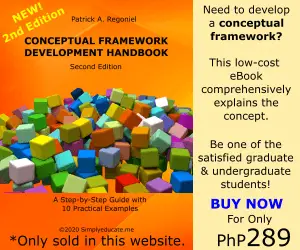
About the Conceptual Framework Handbook Second Edition
The Conceptual Framework Handbook Second Edition provides a more extensive discussion of the topic discussed in the popular eBook of 2016. It offers additional tips on developing a conceptual framework and techniques for building your concept using digital tools for easy construction. Five more examples covered other academic disciplines that can serve as your foundation in developing your research proposal.
The original handbook was written initially in response to the many requests and queries of SimplyEducate.me readers in a previous post titled “Conceptual Framework: A Step-by-Step Guide on How to Make One.” Readers want a more detailed discussion of the topic with practical examples to show them how to go about it.
The Conceptual Framework Handbook Second Edition unravels the mystery surrounding this often confusing portion of the thesis or research paper. For a beginning researcher, a thorough understanding of the conceptual framework and frame one is a prelude to writing a good research paper or thesis. It is the rudder by which the ship sails. You’ll get lost in your research without it.
This 72-page second edition, from the original 52-page eBook, thoroughly discusses the steps to take to develop a conceptual framework that will give you a head start in writing a research paper.
Specifically, the Conceptual Framework Handbook Second Edition aims to:
- define the conceptual framework,
- distinguish the theoretical from the conceptual framework,
- recognize situations whether the conceptual framework is required in qualitative studies,
- point out the need to define terms,
- give tips on how to clarify your research topic,
- identify sources of information,
- help you curate relevant literature,
- generate your research topic
- guide you on the best approach to review and literature and when to stop,
- tell what is a thesis statement and provide examples,
- use digital tools to identify the “gap” in knowledge, and
- provide 10 conceptual framework examples with paradigms that cut across disciplines.
The last objective requires several example frameworks derived from reviews of the literature on the given topics. It’s a painstaking task as it requires reading through a lot of existing literature to get a better idea of the subject at hand. Thus, the e-Book demonstrates how tedious a literature review can be to gain a better picture of research issues or to identify a “gap” in knowledge.
Hyperlinked E-book: A Unique Feature
You can jump right to the examples or topics you are interested in if you already have a good understanding of the conceptual framework. Simply click on the hyperlinked table of contents, which is a unique feature of this eBook. You can do more readings by examining the reference materials through the hyperlinked references that make your browsing experience more convenient. You can also go to the Index page and click on the topic that you want. It’s so convenient to browse the e-book that ultimately saves you precious time.
The literature reviews that support the development of the conceptual framework in the examples use actual research investigations based on real findings in research abstracts. A paradigm is drawn for each topic to illustrate the relationship between independent and dependent variables.
The Conceptual Framework Handbook Second Edition, just like the original eBook, demonstrates what it says, providing practical, real-world examples based on the issues or concerns raised by readers in Simplyeducate.me. This community-driven e-Book thus customizes the discussion to answer the needs of the readers.
GET YOUR COPY NOW!

